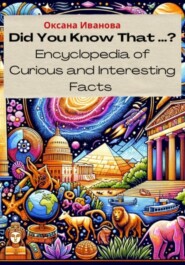скачать книгу бесплатно
taste buds – вкусовые рецепторы
moist – влажный
reduces friction – уменьшает трение
chew – жевать
for maintaining – для поддержания
overall well-being – общее благополучие
a range of – ряд
tooth decay – кариес зубов
oral thrush – молочница полости рта
bad breath – неприятный запах изо рта
decreases – уменьшается
decongestants – противоотечные средства
consumption – потребление
intake – потребление
persistent – постоянный
QUESTIONS:
How much saliva does the average person produce over their lifetime?
What are the main functions of saliva?
What are the consequences of inadequate saliva production?
What factors can affect saliva production?
How can we maintain optimal saliva production?
Fact 10. Did you know that the largest land mammal is the African elephant?
These amazing animals can weigh up to 6,000 kilograms and stand over 4 meters tall at the shoulder. African elephants are known for their intelligence, social behavior, and their importance to the African ecosystem.
Physical Features
African elephants have some very distinctive features:
? Tusks: Both male and female African elephants have tusks, which are long,
curved teeth. Tusks can grow to be over 3 meters long and are used for digging, gathering food, and fighting.
? Ears: African elephants have very large ears that look like fans. They use their ears to cool down by flapping them and increasing airflow.
? Trunk : The elephant's trunk is a very special body part. It is used for breathing, smelling, touching, grabbing things, and making sounds.
Social Behavior
African elephants are very social animals and live in family groups of up to 100 elephants. These groups are led by a female elephant called the matriarch. Elephants communicate with each other using sounds, body language, and smells.
Intelligence
African elephants are very intelligent animals. They have excellent memories and are able to learn new things. Elephants have been seen using tools, working together to solve problems, and even showing kindness to others.
Importance to the Ecosystem
African elephants are very important to the African ecosystem. They help to control the growth of plants and create clearings in the forest that other animals can use. Elephants also spread seeds, which helps to keep the forest healthy.
Threats and Conservation
African elephants are facing a number of threats, including habitat loss, poaching, and conflict with humans. Poaching for their ivory tusks is a major problem, and has led to a decrease in elephant populations. Conservation efforts are underway to protect African elephants and their habitats.
Conclusion
The African elephant is a truly amazing creature that plays a vital role in the African ecosystem. Its intelligence, social behavior, and importance to the environment make it a species that we should all care about. By learning more about African elephants and supporting conservation efforts, we can help to ensure that these gentle giants continue to roam the savanna for generations to come.
WORDLIST:
shoulder – плечо
intelligence – интеллект
physical features – физические характеристики
distinctive – отличительный
tusks – бивни
male – самец
female – самка
curved – изогнутый
digging – копание
fans – веера
to cool down – охладиться
flapping – хлопанье
increasing airflow – увеличение потока воздуха
trunk – хобот
grabbing – хватание
tools – инструменты
solve problems – решать проблемы
clearings – поляны
spread seeds – распространять семена
threats – угрозы
habitat loss – потеря среды обитания
poaching – браконьерство
decrease – уменьшение
generations – поколения
QUESTIONS:
What are some of the distinctive physical features of African elephants?
How do African elephants use their trunks?
Describe the social behavior of African elephants.
How are African elephants intelligent?
What is the importance of African elephants to the ecosystem?
What are the threats facing African elephants?
How do African elephants communicate with each other?
What is the role of the matriarch in an elephant family group?
How do elephants help to control the growth of plants in the forest?
Why is poaching a major threat to African elephants?
What are some conservation efforts that are underway to protect African elephants?
Fact 11. Did you know that the smallest bird is the hummingbird?
These tiny creatures are fascinating to watch, with their bright colors, rapid wingbeats, and ability to hover in mid-air.
Physical Features
Hummingbirds are the smallest birds in the world, with some species being only about the size of a bumblebee. They have long, thin beaks and tongues that they use to suck nectar from flowers. Hummingbirds also have beautiful, iridescent feathers that shimmer and change color in the light.
Flight and Hovering
Hummingbirds are amazing flyers. They can fly forward, backward, up, down, and even upside down. Their wings beat so fast that they make a humming sound, which is how they got their name. Hummingbirds are also the only birds that can hover in mid-air, which allows them to feed on flowers without having to land.
Diet and Feeding
Hummingbirds eat mostly nectar from flowers. They use their long, thin beaks and tongues to reach deep into flowers and suck out the sweet liquid. Hummingbirds also eat insects and spiders, which give them protein and other nutrients.
Importance to the Ecosystem
Hummingbirds are important pollinators. They help to transfer pollen from one flower to another, which helps plants to make seeds. Hummingbirds also help to control insect populations.
Threats and Conservation
Hummingbirds are facing threats from habitat loss, climate change, and pesticides. Conservationists are working to protect hummingbirds and their habitats.
Conclusion
Hummingbirds are amazing creatures that play an important role in the ecosystem. Their beauty, flight abilities, and importance to the environment make them a joy to watch and appreciate.
WORDLIST:
hummingbird – колибри
creatures – создания
fascinating – увлекательный
rapid wingbeats – быстрые взмахи крыльев
ability to hover in mid-air – способность зависать в воздухе
species – виды
bumblebee – шмель
beaks – клювы
suck – сосать
